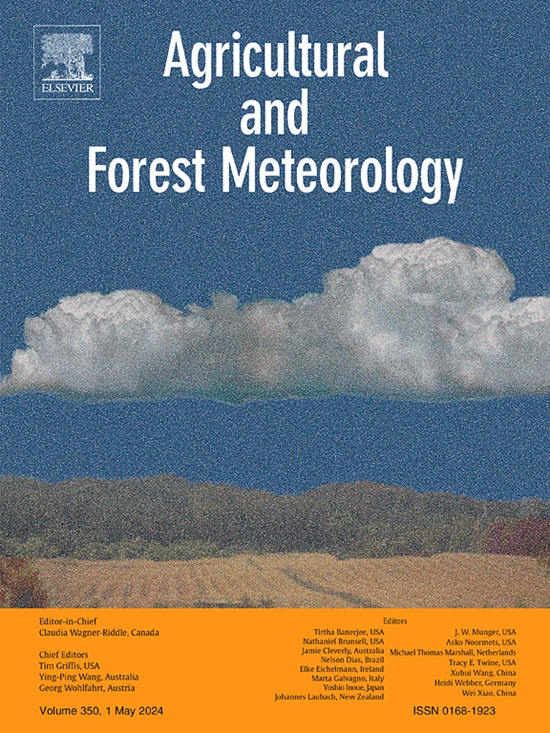Exploring the climate signal in the variation of winter wheat quality records in the North China Plain
IF 5.6
1区 农林科学
Q1 AGRONOMY
引用次数: 0
Abstract
Crop quality is a critical aspect of food security, impacting end-use applications and market competitiveness. There is a well-established understanding of the impacts of climate change on crop yields, while its impacts on crop quality are often overlooked. Given the critical role of wheat in global food security and the ongoing climate change, it is essential to explore the climate drivers in shaping wheat quality. This study utilized county-level survey data encompassing eight quality indicators of wheat grain, flour, and dough during 2006–2019 acquired from 363 counties in the North China Plain, the biggest wheat-producing region in China. The complex association between variation in climate factors and wheat quality was explored using an interpretable machine learning framework. The results revealed that while technological advancements and change in cultivars have improved most quality indicators, especially for dough quality, climate variation during the entire growth period accounts for 10.7 % to 25.7 % of the variations in indicators. Water-related factors had a stronger impact on wheat quality than temperature-related factors. In irrigated zones, precipitation primarily governed test weight and falling number, whereas soil moisture played a key role in determining protein and wet gluten content. In rainfed zones, the standardized precipitation evapotranspiration index (SPEI) was the primary climatic driver of variations in test weight and falling number, while extremely high temperatures predominantly influenced protein and wet gluten content. Additionally, the SPEI exhibits interaction on most indicators with normal growing degree days (GDD). Specifically, the interactive effects between GDD and SPEI reduce dough quality under warm, dry conditions. Conversely, under warm, wet conditions, this interaction negatively impacts test weight and falling number. These findings underscore the importance of drought and the threshold effects of water availability in wheat quality prediction and adaptation, providing an overview of critical quality traits most susceptible to climate and climate extremes variations during the growing season.
探讨华北平原冬小麦品质记录变化的气候信号
作物质量是粮食安全的一个重要方面,影响着最终用途和市场竞争力。人们对气候变化对作物产量的影响已经有了充分的认识,但气候变化对作物质量的影响却往往被忽视。鉴于小麦在全球粮食安全中的关键作用以及正在发生的气候变化,有必要探讨影响小麦质量的气候驱动因素。本研究利用了华北平原(中国最大的小麦产区)363 个县 2006-2019 年期间小麦谷物、面粉和面团八项质量指标的县级调查数据。研究采用可解释的机器学习框架,探讨了气候因子变化与小麦质量之间的复杂关联。结果表明,虽然技术进步和品种变化改善了大多数质量指标,尤其是面团质量,但整个生长期的气候变异占指标变异的 10.7% 至 25.7%。与温度相关的因素相比,与水相关的因素对小麦质量的影响更大。在灌溉区,降水量主要决定了测试重量和降落数值,而土壤水分在决定蛋白质和湿面筋含量方面起着关键作用。在雨水灌溉区,标准化降水蒸散指数(SPEI)是试验重量和降落数值变化的主要气候驱动因素,而极端高温则主要影响蛋白质和湿面筋含量。此外,SPEI 与正常生长度日(GDD)在大多数指标上表现出交互作用。具体来说,在温暖干燥的条件下,GDD 和 SPEI 之间的交互作用会降低面团质量。相反,在温暖潮湿的条件下,这种交互作用会对测试重量和降落数值产生负面影响。这些发现强调了干旱和水分供应的阈值效应在小麦品质预测和适应中的重要性,概述了生长季节中最易受气候和极端气候影响的关键品质性状。
本文章由计算机程序翻译,如有差异,请以英文原文为准。
求助全文
约1分钟内获得全文
求助全文
来源期刊
CiteScore
10.30
自引率
9.70%
发文量
415
审稿时长
69 days
期刊介绍:
Agricultural and Forest Meteorology is an international journal for the publication of original articles and reviews on the inter-relationship between meteorology, agriculture, forestry, and natural ecosystems. Emphasis is on basic and applied scientific research relevant to practical problems in the field of plant and soil sciences, ecology and biogeochemistry as affected by weather as well as climate variability and change. Theoretical models should be tested against experimental data. Articles must appeal to an international audience. Special issues devoted to single topics are also published.
Typical topics include canopy micrometeorology (e.g. canopy radiation transfer, turbulence near the ground, evapotranspiration, energy balance, fluxes of trace gases), micrometeorological instrumentation (e.g., sensors for trace gases, flux measurement instruments, radiation measurement techniques), aerobiology (e.g. the dispersion of pollen, spores, insects and pesticides), biometeorology (e.g. the effect of weather and climate on plant distribution, crop yield, water-use efficiency, and plant phenology), forest-fire/weather interactions, and feedbacks from vegetation to weather and the climate system.

 求助内容:
求助内容: 应助结果提醒方式:
应助结果提醒方式:


